What is selling based on needs?
Finding and knowing a customer’s needs is the central part of needs-based selling. Then, the product or service is positioned as the best way to meet those needs. It’s a type of solution selling where the seller tries to understand the customer’s problems instead of just selling a product.
The needs-based method of sales, or consultative selling, works best when the product is complicated or can be customized often, and the benefits aren’t apparent at first.
Solar comes to mind as an example of a B2C product that can benefit from needs-based selling. Most of the time, needs-based sales strategies are used in the B2B SaaS business.
Other Words for
- “Consultative Selling”
- Dealing with solutions
How needs-based selling can help you make more sales
The salesperson puts the client first in needs-based selling. They give up on the pitch. It’s excellent for the salesperson and their general performance when the buyer feels they’re being helped.
Better Service for Customers
One thing that both B2B and B2C buyers seem to have in common is that they don’t trust sellers. Study after study shows that only 3% of people trust the sellers they talk to.
The numbers show buyers don’t usually respond to cold calls or emails. That’s 85% of prospects who are unhappy with their phone experience.
One big reason for this isn’t that people don’t want to buy. They don’t want to be sold anything. When they smell the commission breath of a salesperson, they start to wonder if the seller wants what’s best for them.
The reverse is true for needs-based selling. They don’t try to convince people they need the goods immediately; instead, they start by listening. Then, they sell the goods as the answer to the problem their customer has.
It makes the customer’s experience much better. The customer knows what they’re getting is good. They work with someone there to assist them during the whole sales process.
Better Experience With Selling
Qualification of leads is pretty hard. Being able to move the wrong leads through the funnel and then seeing them leave after a few months because the offering wasn’t right for them is worse.
A salesperson listens to a prospect’s problems to determine which product will help them the most, how to set it up, and what they need to do to speed up the sales process.
The boss will also know if they aren’t a good one at all. Learning problems ahead of time helps sellers focus their sales activities on the areas where they can make the most difference so they don’t waste too much time on bad leads.
This is a sales job where time is valuable because you don’t spend much time with each client.
It helps people trust each other.
When salespeople know what the customer is having trouble with and then present the product as the best way to fix it, they earn their trust.
The customer thinks they are being heard and looked after. When you consistently sell based on needs, this trust grows into long-term relationships that can keep growing over time.
A consultative approach is also fresh air for prospects, who are generally met with a sales pitch from sellers who aren’t very good at what they do. Being needs-based shows the customer that the seller values their time, which no one wants to feel.
Customized answers to meet customer needs
Sometimes, customers don’t know which option is best for them, especially if they don’t know they have a problem. They don’t always know anything about the goods.
Putting in the extra work to find out what potential customers want and then marketing the product as an answer to that problem will get them to buy something that will help them. Plus, it makes sure they understand how to use it.
Rises in How to Keep Customers
A sales method focusing on the customer makes it easy for vendors to get new customers. Customers who buy already know how the product fits into their lives because the value is made clear from the start. And because these buyers are usually better prepared, it makes it easier for users to join faster and longer.
Because it’s based on value, customer relationships get better over time. The company not only keeps more of its customers, but those customers also become brand ambassadors and tell other people who might be interested in the product about it.
Selling Based on Needs: Steps to Take
This method of selling is made up of seven steps. It starts with learning about the customer and ends with making the sale.
Study: Get to Know Your Customers
People who want to sell can’t lead with value if they don’t do some research first. The rep’s job is to look at the prospect’s present situation and compare it to what they already know about them.
If someone has a LinkedIn profile or website, it’s easy to find out about their job, company, size, and business. When they answer a cold email or book a lesson from the website, they’ll probably give more information about what’s happening in their life.
Start by building rapport.
During this phase, the salesperson doesn’t know a lot for sure. While studying before the call, they will have a few essential facts ready for the conversation.
The potential can tell them they’re wrong. Any way you do it, the buyer will be pleased that you took the time to get to know them.
You don’t need an icebreaker if you use this knowledge to start the conversation on a helpful note. It also helps them get to know each other and gets people to talk about the problems they’re facing.
Ask open-ended questions to find out more.
Let the person talk as they start to open up. The more you know, the better.
Questions with an easy answer, like “Yes” or “No,” are not suitable for sellers. It will be easier to talk to some buyers than others, but the seller should ask many open-ended questions.
From the point of view of a buyer, the goal is to find out if any issues need to be fixed.
Empathy: Pay attention
Active listening is one of the most important skills for people who want to make deals based on their needs.
To actively listen, you need to both understand and react.
Understanding: Listen to what the person is saying and figure out how they feel.
Responding means showing that you’re paying attention without using words, such as by nodding or saying “I see” every once in a while.
The seller must first repeat what they said after the prospect is done with their answer. It’s not a good idea to repeat something word-for-word, but a quick paraphrased outline of the customer’s problem or statement shows that both the seller and the prospect understand each other.
Presentation: Make the Solution Fit Your Needs
Buyers can get an answer that is tailored to their needs in three ways:
Fully customized solution: If a salesperson is selling a product that can be changed in many ways, like business software or custom-made goods, they will make a solution just for the customer that fits their needs and budget.
Semi-customizable solution: A seller may have a few options that can be swapped out to fit the customer’s needs, but they may need to change some details about the product or combine several goods to meet their specific needs.
Value proposition: If a company has a simple catalog of products, the seller will show it to the buyer like they would to anyone else, but they will frame the answer in a way that makes the value speak to them specifically.
Deal with objections: Respond with empathy.
A sales rep rarely closes a deal without some kind of pushback from the person making the choice. Every buyer will have worries and doubts, even if they’re just trying to hide the fact that they don’t want to buy.
To empathize with the buyer, you need to use the same active listening skills to understand, confirm, and address their concerns while keeping the talk on track with solutions.
The goal is to show that you see things from the prospect’s point of view and answer their questions in a way that calms their fears and shows how your product will improve their lives.
To close the deal, stress the benefits.
To get to “Closed Won,” you must tell the prospect how valuable the product or service is.
The seller needs to stress again how their product will help the customer, describe what makes it unique, and list the main benefits that made the customer choose it in the first place.
Most of the time, reminding people of the rewards is more subtle. The goal is to use the talk to remind the prospect of their problems and reposition the product as the best way to solve those problems.
Selling Based on Needs: Things You Should Ask
Open-ended questions based on wants are the key to consultative selling. These ten questions are all great ones to ask:
- “Can you describe your current process or setup for [a specific area or task]?”
- Problems and pain points: “What are some of the biggest problems you have to deal with every day?”
- “If everything worked perfectly, what would success look like for you?”
- 4. An understanding of contrast: “How does the solution you’re using now compare to what you want?”
- 5. Stakeholders and decision-making: “Who else is involved in making decisions about these kinds of solutions?”
- “Do you have a specific budget in mind for solving this challenge?”
- 7. Needs to be met quickly: “How soon do you hope to implement this solution?”
- 8. Future growth and scalability: “Where do you see your business or department in three to five years, and how do you think your needs will change?”
- 9. Other options or solutions: “Have you looked into other options or vendors for this?” If so, what did you like or dislike about them?”
- Value prioritization: “How important is [certain feature or benefit] to you on a scale from 1 to 10? Why?”
Don’t forget that these questions aren’t just meant to get information; they’re meant to start a conversation. You’re paying attention to the client and showing that you want to help them find the best answer for their specific problem.
Technology for Needs-Based Selling That Works
Sales reps can’t have the correct customer information, notes from past talks, or content to back up their conversations if they don’t have the right technology. It’s hard to stay organized and in the customer’s thoughts if they don’t have the right tools.
CRM stands for “Customer Relationship Management.” CRM software can help a sales rep stay organized while they’re selling. With CRM, workers can keep notes and information about customers in one central location. This makes it easy for them to find customer data when needed and ensure they don’t miss any critical details. Deals are tracked in CRM pipeline steps as they move forward.
Making sales possible
Giving buyers the correct information to help them make decisions is part of consultative selling. They won’t spend a lot of time with salespeople on Zoom calls, but they will do their study.
Software that helps with sales knows what’s happening in every sales conversation. Connecting to the rest of the company’s systems gives sales workers instant access to information about customers, prices, product specs, articles, paperwork, and anything else they might need to close the sale.
The needs-based sales method is based on Configure, Price, Quote (CPQ) software, which helps sales reps make custom proposals and product configurations. It helps them make solutions tailored to each customer’s needs, with prices and payment terms that work with their budget.

























































